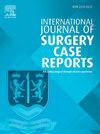Combination of advancement flap and rotational flap as a boon for management of basal cell carcinoma of right supraorbital region: A case report
IF 0.6
Q4 SURGERY
引用次数: 0
Abstract
Introduction and importance
Basal cell carcinoma (BCC) is the most common skin malignancy, primarily affecting sun-exposed areas. Surgical excision with clear margins is the gold standard for treatment. Reconstruction of large defects in cosmetically sensitive areas remains challenging. This case highlights the successful management of a supraorbital BCC using advancement and rotational flaps under local anesthesia.
Case presentation
A 70-year-old female with hypertension and chronic obstructive pulmonary disease (COPD) presented with an ulceroproliferative mass in the right supraorbital region, impairing function. Imaging confirmed a 6 × 4 cm lesion without bony involvement. Due to comorbidities, wide local excision with advancement and rotational flap reconstruction was performed under local anesthesia. Histopathology confirmed BCC with clear margins. The postoperative period was uneventful, with satisfactory functional and aesthetic outcomes.
Clinical discussion
BCC is a locally invasive malignancy with rare metastasis. Sun exposure and immunosuppression are key risk factors. Surgical excision remains the primary treatment, with a recommended 4–6 mm margin. Mohs surgery is preferred for high-risk cases. Reconstruction can be achieved using local, regional, or free flaps. Advancement and rotational flaps ensure adequate coverage with minimal tension. This approach enabled complete tumor excision and optimal wound closure, minimizing surgical risks.
Conclusion
Advancement and rotational flaps effectively manage extensive supraorbital BCC, ensuring tumor clearance and preserving function. This technique provides a viable alternative for patients unfit for general anesthesia. Long-term follow-up is essential to monitor recurrence and optimize outcomes.
求助全文
约1分钟内获得全文
求助全文
来源期刊
CiteScore
1.10
自引率
0.00%
发文量
1116
审稿时长
46 days

 求助内容:
求助内容: 应助结果提醒方式:
应助结果提醒方式:


